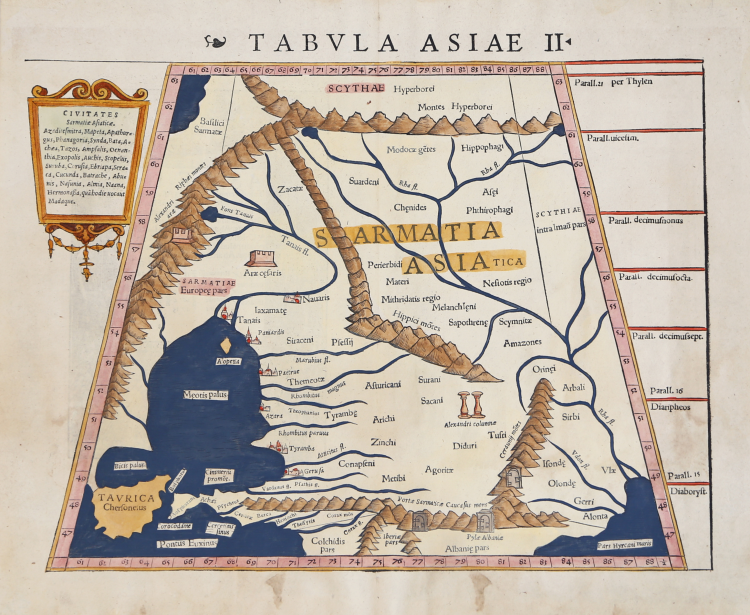



| Reference: | S13363 |
| Author | Sebastian Münster |
| Year: | 1571 |
| Zone: | Ukraine, Black Sea |
| Printed: | Basle |
| Measures: | 380 x 285 mm |


| Reference: | S13363 |
| Author | Sebastian Münster |
| Year: | 1571 |
| Zone: | Ukraine, Black Sea |
| Printed: | Basle |
| Measures: | 380 x 285 mm |
The map shows of part of the Ukraine and the region between the Black Sea and Caspian Sea extending south to include all of Armenia Maior and part of Armenia Minoris.
Trapezoidal projection map from Strabo's Rerum Geographicarum, edition printed in Basileae: Ex Officina Henricpetriana, 1571 Mense Augusto. The work is illustrated by the maps of Sebastian Münster (1488-1552), which first appeared in his 1540 Geographia of Ptolemy, and which are partially corrected in the texts.
The 1571 Rerum Geographicarum is the first edition of the work with commentary and Latin translation by the German humanist and philologist Guilielmus Xylander, also known as Wilhelm Holtzman. It contains 27 maps made from the original woodblocks, first published by Heinrich Petri in 1540, duly amended in the texts.
Strabo (lat. Strabo) was a Greek historian and geographer, born in Amasia, a city in Pontus, shortly before 60 BCE. His main work is the Geography. It seems that it was essentially completed in 7 BC and the author would have done later only a few additions and made some updates, so it would explain the silence on events after 7 BC and at the same time the rare mention of events of 18 AD and a few years later. The work is a vast general treatise on geography. Unlike the Ptolemaic geography, based on a study and analysis more rigidly mathematical, Geography Strabo presents a more historical and anthropological resulting in the most important author of this strand. His great fortune began with the sec. VI and lasted until the modern age.
Woodcut, beautiful hand-coloring, in very good condition.
Sebastian Münster (1488 - 1552)
|
Sebastian Münster was a German cartographer, cosmographer, and Hebrew scholar whose Cosmographia (1544; "Cosmography") was the earliest German description of the world and a major work - after the Nuremberg Chronicle of 1493 - in the revival of geography in the 16th-century Europe. Altogether, about 40 editions of the Cosmographia appeared during 1544-1628. Although other cosmographies predate Münster's, he is given first place in historical discussions of this sort of publication, and was a major influence on his subject for over 200 years.
In nearly all works by Münster, his Cosmographia is given pride of place. Despite this, we still lack a detailed survey of its contents from edition to edition, along the years from 1544 to 1628, and an account of its influence on a wide range of scientific disciplines. Münster obtained the material for his book in three ways. He used all available literary sources. He tried to obtain original manuscript material for description of the countryside and of villages and towns. Finally, he obtained further material on his travels (primarily in south-west Germany, Switzerland, and Alsace). The Cosmographia contained not only the latest maps and views of many well-known cities, but included an encyclopaedic amount of details about the known - and unknown - world and undoubtedly must have been one of the most widely read books of its time.
Aside from the well-known maps and views present in the Cosmographia, the text is thickly sprinkled with vigorous woodcuts: portraits of kings and princes, costumes and occupations, habits and customs, flora and fauna, monsters and horrors. The 1614 and 1628 editions of Cosmographia are divided into nine books. Nearly all the sections, especially those dealing with history, were enlarged. Descriptions were extended, additional places included, errors rectified.
|
Sebastian Münster (1488 - 1552)
|
Sebastian Münster was a German cartographer, cosmographer, and Hebrew scholar whose Cosmographia (1544; "Cosmography") was the earliest German description of the world and a major work - after the Nuremberg Chronicle of 1493 - in the revival of geography in the 16th-century Europe. Altogether, about 40 editions of the Cosmographia appeared during 1544-1628. Although other cosmographies predate Münster's, he is given first place in historical discussions of this sort of publication, and was a major influence on his subject for over 200 years.
In nearly all works by Münster, his Cosmographia is given pride of place. Despite this, we still lack a detailed survey of its contents from edition to edition, along the years from 1544 to 1628, and an account of its influence on a wide range of scientific disciplines. Münster obtained the material for his book in three ways. He used all available literary sources. He tried to obtain original manuscript material for description of the countryside and of villages and towns. Finally, he obtained further material on his travels (primarily in south-west Germany, Switzerland, and Alsace). The Cosmographia contained not only the latest maps and views of many well-known cities, but included an encyclopaedic amount of details about the known - and unknown - world and undoubtedly must have been one of the most widely read books of its time.
Aside from the well-known maps and views present in the Cosmographia, the text is thickly sprinkled with vigorous woodcuts: portraits of kings and princes, costumes and occupations, habits and customs, flora and fauna, monsters and horrors. The 1614 and 1628 editions of Cosmographia are divided into nine books. Nearly all the sections, especially those dealing with history, were enlarged. Descriptions were extended, additional places included, errors rectified.
|